Welcome to Petra
Yes, we finally made it! And boy, was it amazing!
The trip to Petra was amusing. Getting over the border took more than an hour, following which we took two cabs (one to Aqaba and one to Petra) on a crazy road with the cabbie driving like a madman past shacks, sheep, goats, and lots of sand. We shared the ride with a an American family we met while crossing the border; they were going just for the day, so we negotiated with the taxi driver for a slightly better fare (we think).

The road climbed several mountains, and at the top of one of them we took the picture above.
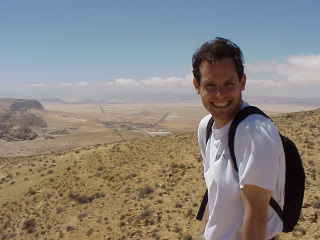
It was about 75 degrees Fahrenheit in Eilat, but perhaps 50 at the top of the mountian. Brrrr!!!
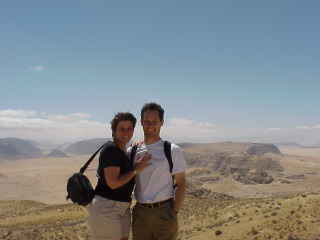
The cabbie kindly took the photo above, following which we all ducked back in the taxi to get warm. In case you can see it, the view is of Wadi Rhum, or Rhum Valley
Once we got to Petra, we checked into our hotel, the Petra Forum, which was a tad expensive but worth it; we didn't have to worry about our bags, it had a safe for valuables we didn't feel like carrying, the staff was quite helpful, and the location couldn't have been better; it was just outside the entrance to the park. After lunch we bought our 25 dinar ($35) two-day passes and started walking. The family with whom we shared the taxi hired a guide, Hani, who led us on a short (but later extended) tour of the main sites (and then on a nice hike).
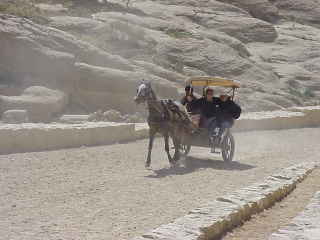
These horse carriages bump along down the canyon (or Siq) into the ruins. Granny would have had to brave this rocky ride! We walked.
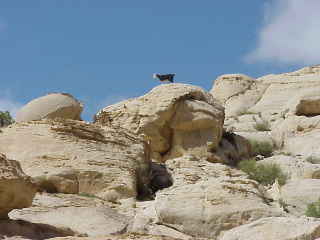
Tourists share Petra with various animals, including this goat.

All along the siq on either side are aqueducts; the Nabateans who carved Petra in the 1st centuries B.C. and A.D. were quite the engineers, and they marshalled their water resources quite successfully. The intricate water system carrying water into the city and collecting water along the way comprised two sets of channels--one in rock and one in clay pipes for the royalty. It wasn't until the Romans altered the trade route and earthquakes damaged the aqueducts that Petra fell from its exalted status as center of the Nabatean empire.
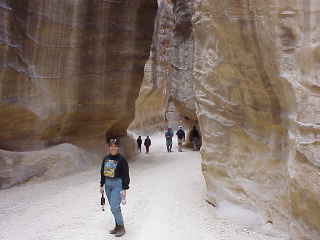
Above is a picture of Monica in the Siq on the way to the Treasury, or al-Khazneh (a building you can see below).
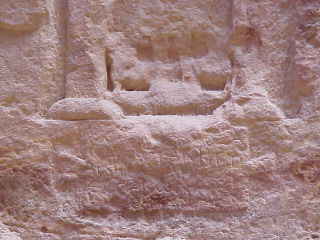
The Nabateans, who built this city before the Romans took it over, carved and built many monuments and places for offerings along the Siq. They weren't dumb--the cavern is incredibly impressive as well as being impregnable by the military. In the picture above, you can see the faint remains of etchings in Greek.
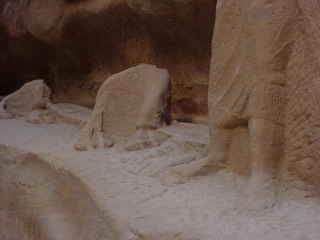
Many carvings once lined the walls. All that remains of this set are human and camel feet. Quite a feat, Petra.
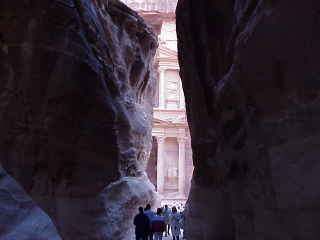
This photo above and the two following are the so-called "Treasury" building, named by the invaders who thought that the urn at the top contained gold. Quite an impressive site when first seen through the opening in the narrow canyon that widens into the Nabatean city.
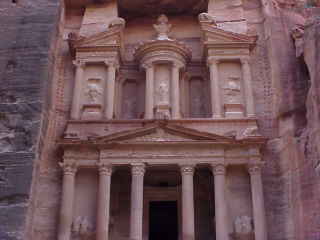
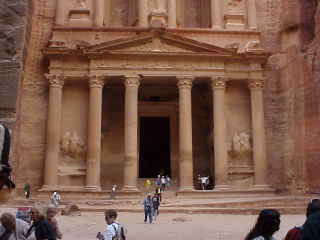
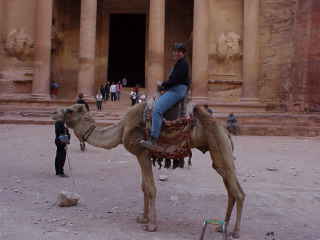
Of course, the ever-present salesmen convinced us to get Monica up on a camel for a photo.

Adam didn't get up on a camel until later.
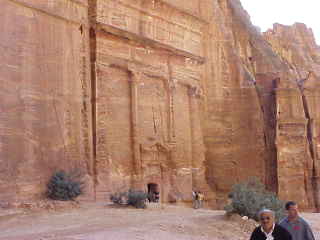
These facades are all carved into the walls of the canyon. There were no tools found at the site by archaeologists, so they have no idea what the Nabateans used to carve the buildings. When you see the full extent of the city, however, you realize what an incredible task it must have been.
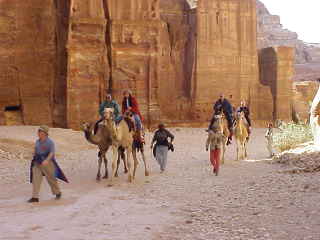
Monica loved the many camels passing on the walk.
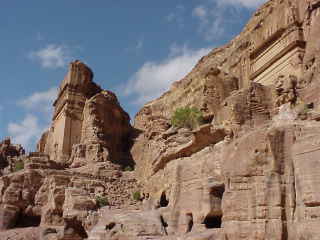
The picture above and the three below can give a tiny sense of the vastness of the city of Petra. Many, many levels of building rise from the canyon floor, and there is a lot of evidence of buildings still buried in the sand.
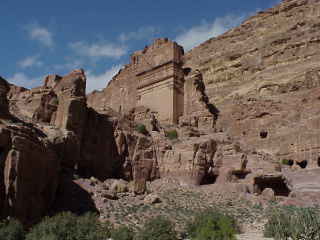
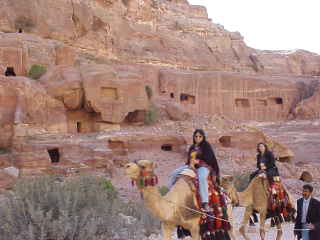
It is generally believed that many of the caves were designed to hold the dead; Nabateans believed in reincarnation, so they lived and worshipped very close to their ancestors' remains.
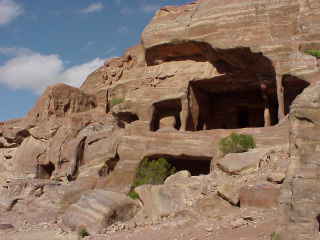
Below, Monica stands in front of the "Silk Tomb," so called because of the rich colors of the rock into which it was carved.
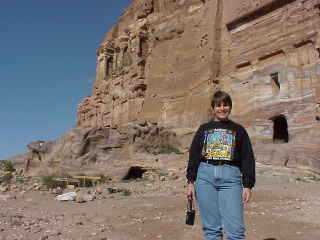
At this point, Hani's official "short" tour ended, but we decided to pay the extra fee to have him guide us on a hike up to a great lookout point far above the Silk Tomb.
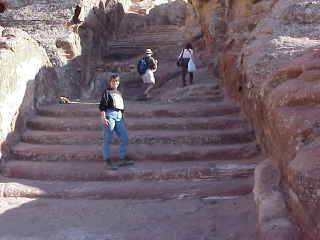
The photo above proves that Monica made the climb up hundreds of steps to a panoramic view of the valley. These steps are the original Nabatean steps carved directly into the hill. They are somewhat worn down, so the Jordanian Department of Antiquities has added some steps and reinforced some areas. Nevertheless, the Nabateans' carving has stood the test of time in many places.
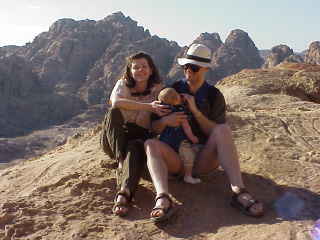
This is the family with whom we shared the cab to and tour of Petra: Lisa and Michael and their son Patrick (very cute at just six months old).
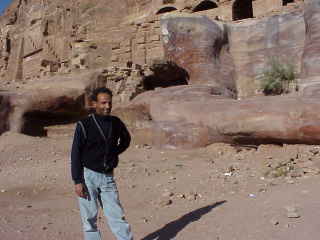
Above is the guide, Hani. It turns out his brother Hisham owns the Internet Cafe in town, so we saw him again later in "civilian clothes," so to speak.
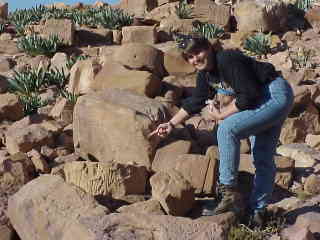
Along the side of the walk, there are many columns litered about the path. Monica posed by a couple of carved column capitals.
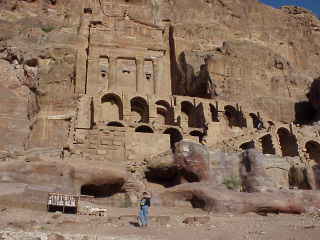
Above is the Urn Tomb, another carved tomb (and quite an impressive one, I might add, although it was not as well preserved as the Treasury).
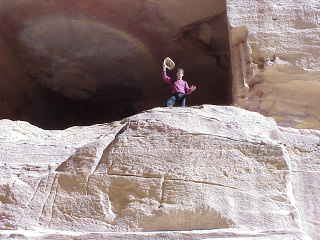
"Farmer Adam" waves from atop a stairway to one of the carved homes...
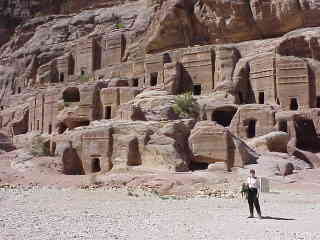
...and Monica poses in front of a set of Nabatean homes (whether for the living or the dead, we weren't sure).

Monica liked this picture of the triangle-carved building capitals.
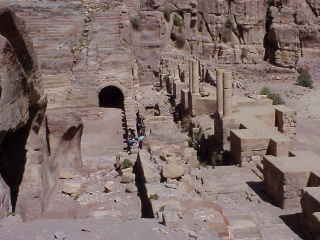
On our second day, we ventured out without a tourguide, and saw many of the things we had seen from on-high the day before. Adam was impressed by the Nabatean forum, which had great acoustics. This is a view from the side.
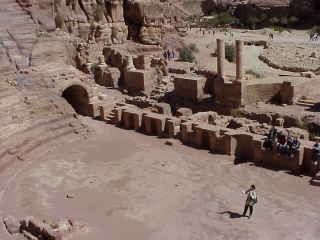
And here is a picture of Monica in the forum.
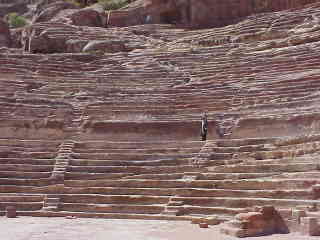
We tried to capture the essense of the size of the forum; see if you can find Adam (very tiny) in the seats.
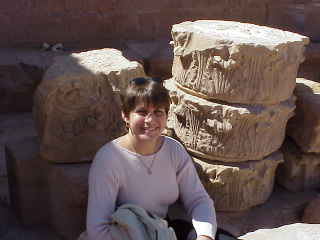
After the forum, we walked along the colonnaded street; some of the columns were better preserved than others.
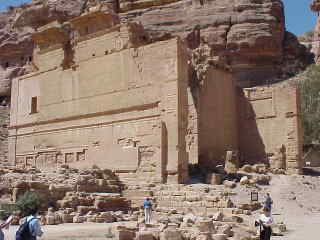
Only one free-standing building remains in Petra, damaged but not completely toppled by earthquakes. It was amazing in itself.
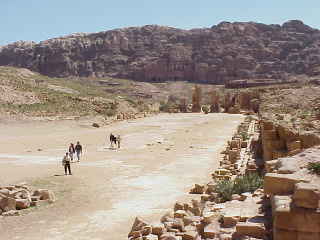
Here is a picture of Monica in front of the building.
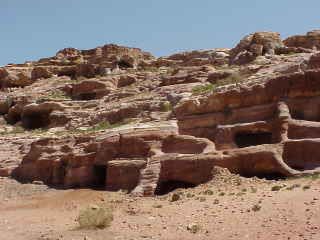
This is a picture of what we think was a necropolis (city of the dead).
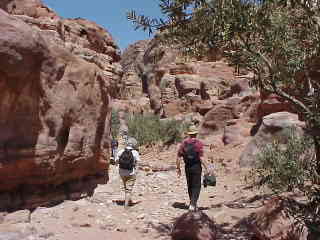
After pausing to eat oranges we bought the night before, we set out on a hike up to al-Deir, the Monastery, which we didn't realize was really that far away. It took almost 2 hours to hike there, but only 45 minutes to hike back (coming back it was downhill all the way).
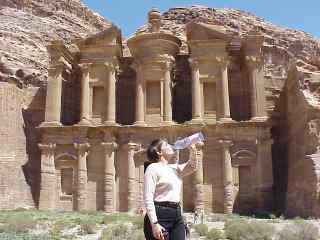
At the top/end of the hike, we realized it was worth it; here is a picture of Monica guzzling water while she catches her breath; the Monastery is in the background.
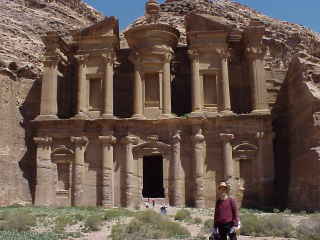
And here is Adam in front of the Monastery.
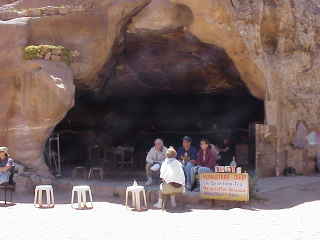
Across from the building is a cave-restaurant that sells bottled water for the low price of a half-dinar (70 cents). I'm sure the owner could charge a lot more and still sell the same quantity. We bought three bottles.
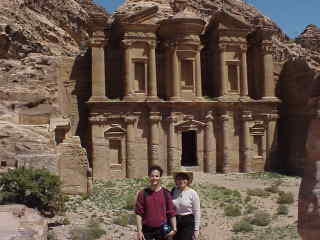
A kind Brit took this photo of us in front of the Monastery.
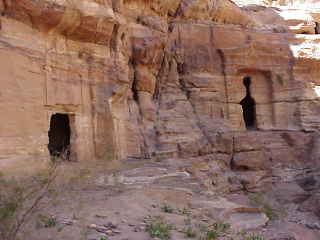
On the hike back, we paused to see the Lion's Trinculum, but didn't see any lions.
Once we made it back to the colonnaded street, we thought we would splurge, so we ate a fabulous lunch (took a real photo, not a digital one; sorry) at a linen-tablecloth-and-silver-utensil restaurant; it wasn't until we got the bill that we were surprised. It was only 16 dinars ($22 or so) for the two of us.
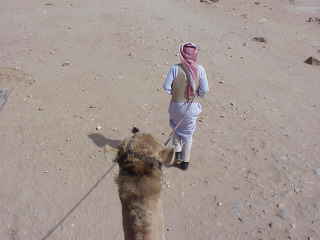
So we decided to splurge and took a camel ride back. Unfortunately, the bedouin wanted 18 dinars for the ride, and we thought that was too much, so we bargained him down to 13 dinars (in the end we gave him a $20 bill, which was about the same).
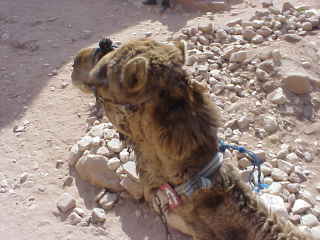
He seemed none too pleased to have to lower the price, so we think that maybe to spite us he decided to speed up the trip.
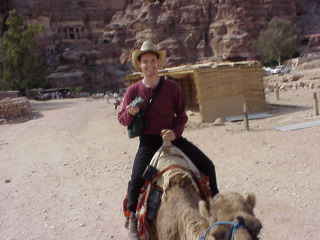
The photo above is of Adam on the camel behind me; I have no idea how the real photos came out, because we were bumping along at quite a trot. But luckily the digital camera allowed me to see immediately afterward how the picture came out; I even deleted a few on the way, and re-shot them. This was the best.
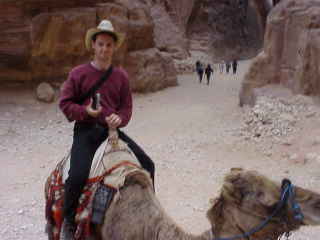
Or maybe this was.
After the ride, the bedouin hissed and my camel plopped suddenly down; I tried to get a real picture of Adam on his camel while it was standing, but I got an action shot instead as the bedouin hissed and the camel began to plop down.
That was pretty much the end of our trip in Petra; after our walk back out through the siq we hailed a cab to take us back to the Petra Internet Cafe for a short while. The pictures below are from the night before and from that afternoon.
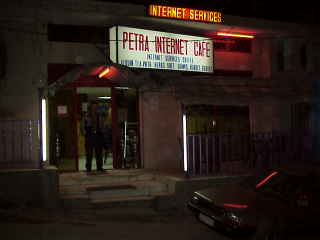
Above is the view outside the Petra Internet Cafe in the center of Wadi Mousa, the town abutting the Petra ruins.
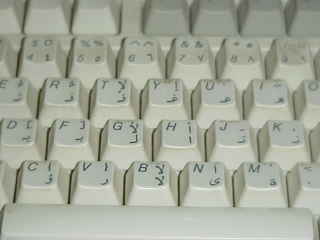
The Arabic/English keyboard caused similar problems to those we experienced with the Hebrew/English keyboards in Israel.
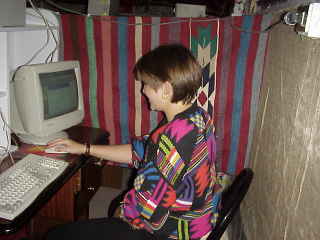
Monica sits at a computer at the Petra Internet Cafe.
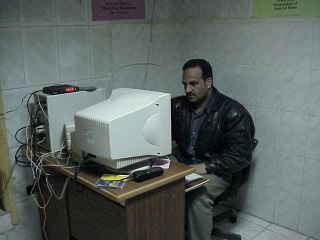
Internet Cafe owner Hisham al-Masadah (Hani's brother) puzzles over creating his new Web site...
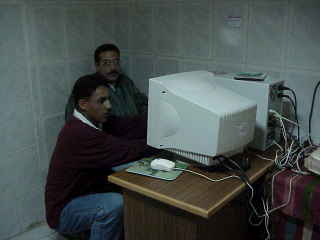
...and gets advice from his younger brother (I guess it's kind of a family business).
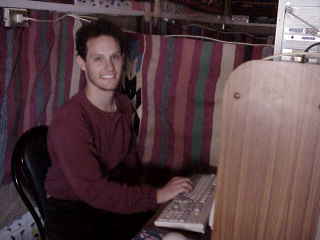
Adam in Petra's Internet Cafe.
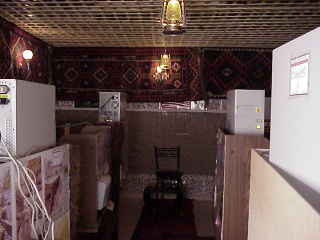
The inside of the computer room (Hisham has 7 PCs not including his own).
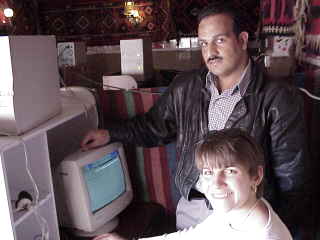
Monica working on one of the PCs, with Hisham behind her.
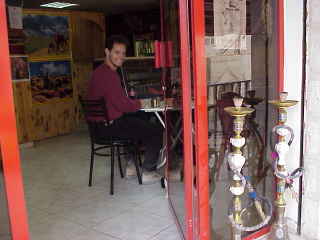
Adam relaxing inside the cafe on Saturday afternoon (we sipped a Coke and watched Iraqi soap operas for a short while, and our taxi driver drank his Turkish coffee).
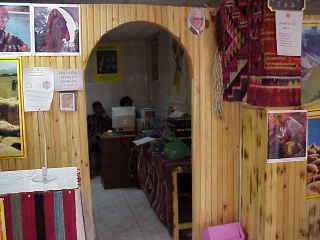
View from the cafe part of the Internet Cafe into the computer part.
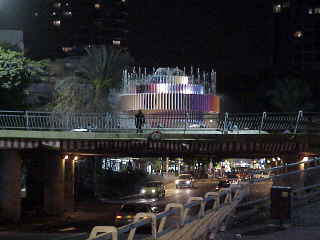
And, finally, an image not of Petra but of Dizengoff Square, in Tel Aviv, which we took on our way to the InBar, where we spent our last evening in Israel uploading all these photos and most of the text. Hope you enjoyed touring with us!
Click below to see what we did in the following places; in particular, click on the last button to read a "post-mortem" of the trip. ...
Last updated March 31, 1999.